Browse Houses
Search Results: Returned 5516 records. Displaying results 2401 – 2500
| House name | Description | |
|---|---|---|
| Finavarra House | The home of the Skerrett family from the mid 18th century to the mid 19th century, now a ruin. |
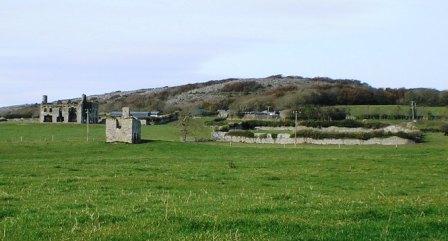
|
| Finisk Mill | Denis Keily was leasing this property from the Power estate in 1850 when the house and mill had a combined valued of over £37. It is labelled Finisk Flour Mill on the First edition Ordnance Survey map and as Finisk Corn Mill on the later 1890s edition. A creamery building later occupied the site. | |
| Finisklin House or Seamount | Built as a seaside residence of the Wood family though frequently leased by them to various other families. In the mid nineteenth century it was the residence of Thomas Mostyn Wood and valued at £11. In the 1870s, McTernan notes that it passed to the land agent Richard St. George Robinson, in whose family it remained until the early twentieth century. It is still extant and has been restored. | |
| Finn Lodge | Sir Frederick Heygate's estate held this property in fee at the time of Griffiths Valuation in the 1850s, when it was valued at £11. Farm buildings occupy the site now. | |
| Finned (Tireragh) | At the time of Griffith's Valuation, George Beatty (or Beattie) was leasing a house valued at £5 and almost 100 acres from the Tottenham estate. McTernan states that he was referred to at the time of the Ordnance Survey as a "middleman for a large amount of property". Later the house passed by marriage to the Boyd family who sold it in the early twentieth century. It is still extant and has been renovated. |

|
| Finned House | In 1906 Sir Jocelyn Gore Booth owned buildings valued at £8 at Finned, barony of Carbury. This is likely to be Finned House. This townland was the property of the Gore Booth estate at the time of Griffith's Valuation but the highest building valuation at that time was only £2. | |
| Finnis | Thomas Gash was leasing offices from the Devonshire estate in 1851 when the buildings were valued at £11. A house and extensive farm buildings exist at the site now. | |
| Finniterstown | Mr Edmund Hogan was resident at Finniterstown in 1814. The Ordnance Survey Field Name book records the building of a 2 storey house at Finneterstown in 1833 and that it was occupied by William Fosberry circas 1840. Located on the St Leger estate this house was occupied by Frederick Maunsell in the early 1850s and was valued at £11. | |
| Finnoe | Occupied by T. [Thomas Maunsell] Waller in 1837. The Ordnance Survey Name Books describe Finnoe as "a commodious house" in 1840. Thomas' son, Edward Waller, was the occupier at the time of Griffith's Valuation. Edward held the property in fee and the house was valued at £30. A building is still located at this site. | |
| Finnor House | At the time of Griffith's Valuation, Richard O'Farrell Caddell was leasing a house valued at £8, at Finnor, barony of Boyle, to Michael Barrett. It s labelled "Finnor House" on the 25-inch Ordnance Survey map of the 1890s and a house still exists at the site. | |
| Fintragh | Anne Hamilton was occupying the house at Fintragh at the time of Griffith’s Valuation when it was valued at £16. A newer house was constructed at Fintragh in the later 19th century[G689766]. It was burned in 1923, though reconstructed before being demolished in the later 20th century. The stableblock, built on the site of the original Fintragh House, is still extant, and has operated as a restaurant. |
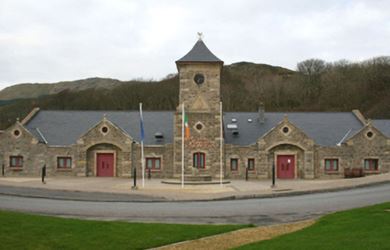
|
| Finuge House | Rev. Maurice Hewson was leasing this property to William M. Hewson as the time of Griffith's Valuation, when it was valued at £13 5s. In 1837, Lewis notes it as the seat of W. Hartnett. Bary states that it was burnt in the early twentieth century and nothing now remains. | |
| Firgrove | Hogan writes that the building of Firgrove was begun by Thomas, son of Thady O'Halloran, the diarist, and completed by John MacMahon of Knockane. John Peter Kelly took over the house from MacMahon. In 1851 Eliza, daughter of John Scott of Firgrove, married George Fosbery of Clorane, county Limerick. The house was occupied by Charles Butler in the mid 19th century who held the property from John Kelly. It was valued at £35. The house was demolished in the 1920s. |

|
| Firgrove | At the time of Griffith's Valuation, the representatives of Chambre Corker were leasing this property to Richard Quinn when it was valued at £18. In 1837 Lewis notes it as the seat of R. Quin. In 1906 it was held by the representatives of Mary Quinn and valued at £7 10s. A house still exists at this site. | |
| Firmount | A Townsend family home, occupied by Horace Townsend in 1837 and by William Coghlan at the time of Griffith's Valuation. It was then valued at £14.10 shillings and was held from Horatio Townsend. The sale rental of 1877 records a fee farm grant of Firmount from John Crewe Chetwood Townsend to Arthur Chute dated 1871 and a fee farm grant from Arthur Chute to J.C.C. Townsend executed the following year. A house is still extant at the site. | |
| Firmount | The seat of the Firman family in the late 18th century, occupied by Thomas P. Terman in 1814. The house is marked on the first edition Ordnance Survey map. The Ordnance Survey Name Books refer to it as "the mansion house of Firmount now falling into ruins, It appears to be a ruin by the time of Griffith's Valuation. The only buildings over £10 valuation were the Santa Cruise flour mill and house of Samuel Palmer. The Irish Tourist Association surveyor records "an extremely charming house converted from stabling" at Firmount and occupied by Major H.H. Deasy in the early 1940s. The surveyor states that the original house was destroyed by fire. | |
| Firville | In 1841 the Ordnance Survey Name Books refer to "Ferville" as the residence of R.F. Drought. William S. Smith occupied the house in the mid 19th century which he held from Ralph Smith. It was valued at £15+. This building is still part of a farm complex. | |
| Firville | Leet lists a Robert McCarthy residing at a house called Fir-ville, Macroom in 1814. Lewis refers to Firville, the newly erected mansion of Philip Harding. Henry Harding was the occupier in the early 1850s holding the property from N.D. Murphy. It was valued at £19.10 shillings. The representatives of Henry Harding still owned Firville in the 1870s. Firville passed to the Barry family through the marriage of Ellen Harding, daughter of Henry Harding, and Thomas Barry, son of Michael Barry of Elm Park, Farran, county Cork, land agent to Sir Riggs Falkiner. In 1944 the Irish Tourist Association Survey noted that Firville was then the residence of F. St.Aubyn Horgan, who had connections with the Channel Islands. Firville is still extant and occupied. | |
| Firville | A home of the Atkins family in the 18th and 19th centuries which in the early 1850s was held from John Clarke with 251 acres. Major Atkins occupied the house in 1814 and R. Atkins in 1837. Hajba writes that the Reverend Philip Atkins-Going left Firville to his unmarried daughters Charlotte and Henrietta when he died in 1861. Hussey de Burgh records Mrs Charlotte Henrietta Atkins of South Mall, Cork, owning 502 acres in the 1870s. Sold to Samuel Sheehan in 1914 this property still belonged to his descendants at the beginning of the 21st century. |
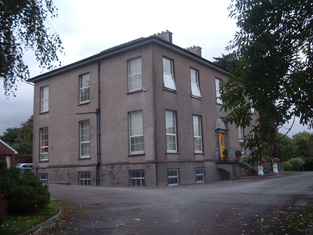
|
| Fisherhill | Occupied by Major Blake in the early 19th century. Fisherhill and the lands of Carheens, were leased by Richard D'Arcy of New Forest, county Galway to Edward Cheevers of Killyan, county Galway on 23 Mar 1858. In 1879 Robert Ireland advertised for sale his interest in Cheevers lease. A. C. Larminie lived here in the late 19th century. Now the home of the McGreal family. |
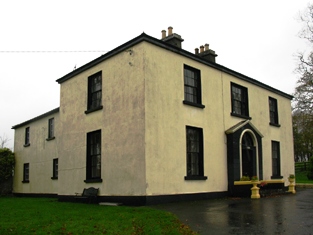
|
| Fishmoyne | A junior branch of the Carden family lived at Fishmoyne from the mid 18th century. Bence Jones writes that the house was built in the 19th century replacing the original house which was destroyed by fire. Wilson, writing in 1786, notes Fishmoynne as the seat of Mr. Carden. A Mrs Butler was resident in 1814 and R. Minchin Carden in 1837. Richard Carden held the property in fee in the early 1850s when it was valued at £56.17 shillings. This house remained the property of the Carden family until 1955. The Irish Tourish Association survey records the house as "idle and locked up" in the early 1940s. Fishmoyne is no longer extant. | |
| Fivemilebridge Mill House | Joseph Coghlan was leasing this property to William Herrick at the time of Griffith's Valuation, when it and the adjacent mill were valued at £53. The mill buildings are no longer visible on the 25-inch map of the 1890s. The house is still extant. |
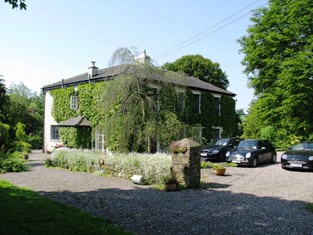
|
| Flanker House | The Walsh estate, including Drumsna House, was advertised for sale in the Landed Estates' Court in 1861. The sale notice describes the dwelling house as "handsome and commodious" with a large walled garden. At the time of Griffith's Valuation Mary Anne Walsh was leasing the house, valued at £22 from Josias Rowley. The accompanying map indicates that it was called Flanker House. In the 1870s several members of the Keogh family, with an address at Flanker House, Drumsna, held property in county Roscommon. |

|
| Flaxfort | Occupied by R. Martin in 1837 and by Mary Anne Martin at the time of Griffith's Valuatioan. The house was valued at £21 and held from John Purcell. It is no longer extant. |
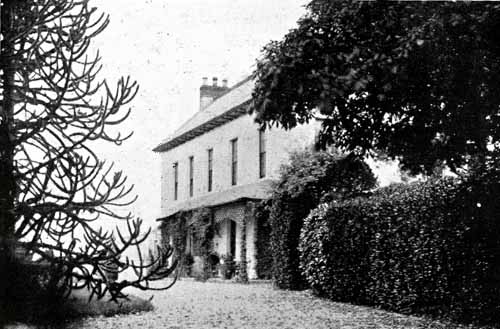
|
| Flaxfort House or Seaview House | At the time of Griffith's Valuation, William Scott was leasing this propert to Rev. Robert Taylor, when it was valued at almost £10. Lewis records it as the residence of Rev. Robert Taylor, PP, in 1837. It is labelled Seaview House on the 1st edition Ordnance Survey Map but it had become known as Flaxfort House soon after. | |
| Flesk (Glenflesk) Castle | Daniel C. Coltsmann was in possession of Flesk Castle at the time of Griffith’s Valuation when it was valued at £50. Lewis records it as the seat of J. Coltsmann in 1837. Bary states that the house was also known locally as Glenflesk Castle or Coltsmann’s Castle. It was built in the early decades of the 19th century and continued in the Coltsmann family and their descendents until the early 20th century when it was sold to Major John McGillycuddy. In 1943 the Irish Tourist Association survey noted that "its tall fantastic turrets dominate the countryside". It was then in the possession of Anthony McGillycuddy. It had become ruinous by the end of the 20th century although there were some indications that it might be restored. |
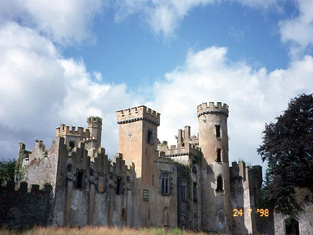
|
| Flesk Cottage | At the time of Griffith’s valuation, this house is recorded as part of the Herbert estate but was unoccupied. It was valued at £24 at the time. Lewis records it as the seat of Capain Godfrey in 1837. The Ordnance Survey Name Books record it as the residence of Arthur Saunders c.1840. Bary states that this house was frequently occupied by the Godfrey family. The ruins are close to the Gleneagles hotel. | |
| Flesk Lodge | At the time of Griffith’s Valuation, Rev. Richard Herbert was leasing a property to Rev. Robert Hewson when it was valued at £6 10s. Bary states that the latter is recorded as having died at Flesk Lodge in 1880. Since 1957 the site has been occupied by the Gleneagle hotel. | |
| Flesk Priory | The representatives of John Coxon were leasing Flesk Priory to Margaret Newman at the time of Griffith’s Valuation, when it was valued at £26. In 1837 Lewis mentions it as the seat of J.S. Coxon. Bary states that, while O’Donovan claimed it had been built in 1828, it is possible that it was erected in the 18th century. Local tradition maintained that it was to provide accommodation for noble refugees from the French Revolution. It was still extant at the end of the twentieth century. | |
| Flintfield House | This house was a seat of the Chinnery family from the mid 18th to the mid 19th century. It was occupied by Barry Cotter in 1814 and by Denis O'Connell in 1837 and at the time of Griffith's Valuation. The buildings were valued at £18+ and the property was held from John Orpen. Home of the MacSweeneys in the 20th century. |
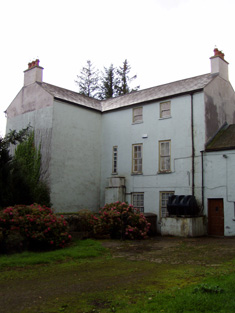
|
| Flower Hill | Flower Hill was being leased by Magdalene Irwin from the Perceval estate at the time of Griffith's Valuation when it was valued at £3. The Irwins had a modest house at this location and in the 1820s set about building a larger property. Due to debt and court proceedings it was never finished and remains a roofless ruin. | |
| Flower Hill | Flower Hill was occupied by Anthony F. Nugent at the time of Griffith's Valuation when it was valued at £28. IN 1894 it was the residence of Charles Nugent. Flower Hill is still extant and now operates as an equestrian centre. See www.flowerhill.net |

|
| Flowerhill House (Waterford) | Flowerhill was leased by Nelson T. Foley to Barry Drew in 1851. Lewis also refers to it as the seat of B. Drew, describing it as " a beautiful residence in the cottage style". The house is no longer extant. | |
| Fohenagh | Sir Henry Grattan Bellew dates this house from the 1830s. In 1906 Norah Johnston was the owner of buildings valued at £10 at Fohenagh as well as over 500 acres of untenanted land. Various members of the Johnston family had held lands in the area at the time of Griffith's Valuation mostly leased from the Hodson estate. Buildings still remain at this site. | |
| Ford Lodge | Located on the Farnham estate just outside Cavan town and close to St Patrick’s Cathedral, Fort Lodge is named on the first edition six inch Ordnance Survey map (publ. 1837). R. Young Reynolds of Fort Lodge, Cavan, was a subscriber to Lewis ‘Topographical Dictionary’. It was occupied by Theophilus Thompson in the mid-19th century and valued at £27 for rates. Home of William Henry Halpin, a solicitor, in the 1930s. | |
| Forest House | In 1750 William Spread was living at Forest and in the 1770s and 1780s Spread Esq is recorded as resident at Forest. In 1814 Leet records this "seat" as unoccupied. T. Gollock was resident in 1837 and Thomas Gollock held the property in fee at the time of Griffith's Valuation when it was valued at £38. Slater records it as the seat of Rev. T.H. Gollock in 1894. Forest was burnt in July 1921 just before the end of the War of Independence when it was the property of James Gollock and occupied by Lt. Col. Isaac Burns-Ludlow. The Irish Tourist Association survey refers to this in the 1940s as it having been burnt "as a military precaution". It is no longer extant. | |
| Forest View | This house is named on the 1st edition 6 inch Ordnance Survey Map (1836). In the mid-19th century it was occupied by Thomas Dawson and held from Lord Cremorne. The buildings were valued at £12. Partial remains are still visible at this site. | |
| Fort Anne | The residence of S. E. Johnson in 1837, built by his father William. The house was occupied by Richard Johnston in the early 1850s who held the it from the Reverend R. Dickson, who held the demesne in fee. In 1906 this house valued at £13.15 shillings was occupied by William D. Dickson. The original house is no longer extant. | |
| Fort Anne | An 18th century house that was in the possession of Robert Westropp, eldest son of Poole and Mary Westropp, by 1814. His son John, who married Maria Macnamara, was occuping the house in 1837 and their son Robert was resident in the mid 1850s. Robert Westropp held the property in fee and the buildings were valued at £25. This house passed into the possession of the O'Callaghan Westropp family. It no longer exists. | |
| Fort Arthur | Bartholemew Donovan was leasing this property from John Young Sandys in 1851 when it was valued at £7. It is labelled Fort Arthur on both the First and 25-inch edition Ordnance maps and is still extant. | |
| Fort Browne | By the mid 1850s the house was valued at £2.15s and was occupied by Margaret Burke. It is now derelict. |

|
| Fort Edward | Fort Edward was the home of Edward Long from at least the mid 1830s and is referred to as his residence by the Ordnance Survey Name Books in 1840. At the time of Griffith's Valuation he held the property from Charles Bianconi and the buildings were valued at £19+. Still extant and occupied. |
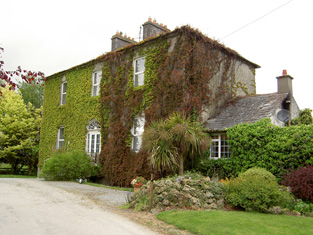
|
| Fort Edward | Built post the first Ordnance Survey probably by a member of the Westropp family. Occupied by Dr Patrick Cullinan at the time of Griffith's Valuation who held it from the Reverend John Gleeson. The house is still inhabited and well maintained. |
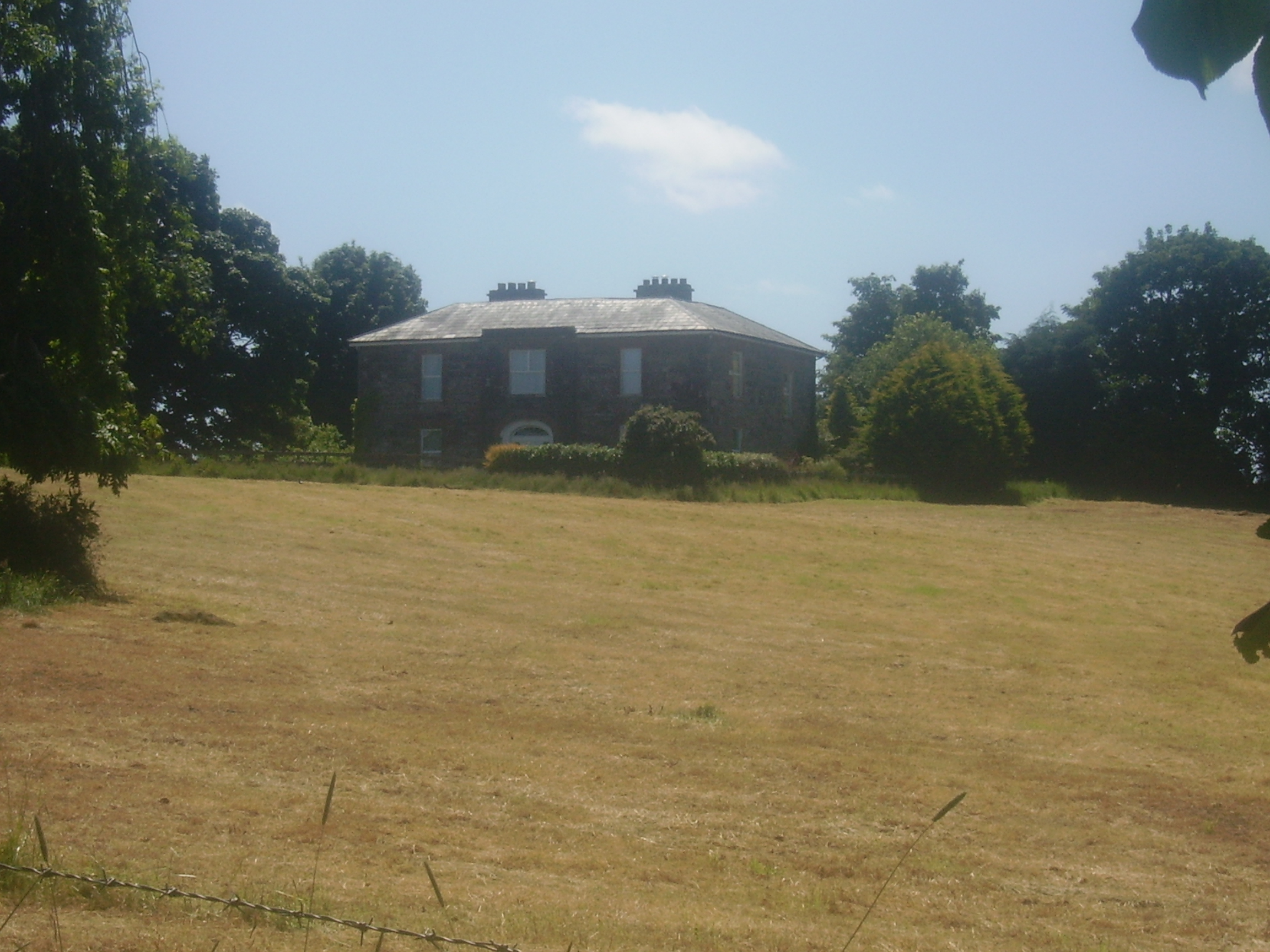
|
| Fort Elizabeth | Occupied by John Cripps in 1814 and the residence of the Reverend John Croker in 1837. William Croker was the occupier at the time of Griffith's Valuation when it was held from the representatives of James O'Sullivan and valued at almost £16. A substantial farm remains at the site. | |
| Fort Etna | The home of the Peacock family in the 19th century, although J. Waller O'Grady was resident in 1837. At the time of Griffith's Valuation it was occupied by Mrs Peacocke who held it from Charles Leslie, valued at £30. Occupied by Edmund White in the 1870s Bence Jones records that it later became the home of the Reilly and Peart families. The original house is now a ruin. | |
| Fort Eyre | At the time of Griffith's Valuation a property here, owned by Reverend E. Maunsell, was being leased by Richard A.H. Kirwan and was valued at £42. The house is labelled Fort Eyre on the 1st edition Ordnance Survey map. It is still extant. |
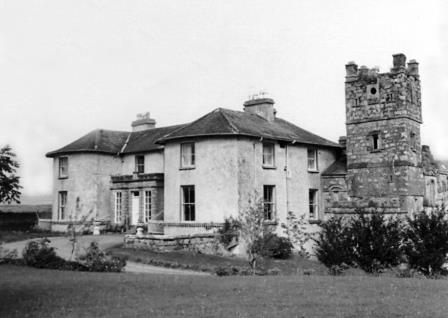
|
| Fort Fergus | A home of the Ross Lewin family in the 18th and early 19th centuries. In 1786 Wilson refers to it as the seat of J. RossLewin. Occupied by Mr Evans in 1814 and by Daniel O'Grady in 1837 and held by Major William Ball in fee in the 1850s, when the buildings were valued at over £32. Bence Jones writes that Major Ball purchased Fortfergus in 1855 in the Encumbered Estates' Court. Weir writes that the house was burnt down in the 1920s. The remaining staff quarters have been turned into a residence and the farm buildings are still in use. | |
| Fort Frederick | Fort Frederick situated close to the shore of Lough Ramor was described by Bence Jones as ‘a 2 storey mid-c18 house with a central 3 sided bow and 2 bays on either side of it’. In 1814 it was the home of Captain Sankey but by 1837 had been acquired by his relative R. Scott who was married to Eleanor Sankey. Griffith’s Valuation records Richard Scott as the occupier. The buildings were valued at £35 and were held in fee. By 1876 Alexander William Jackson Sankey owned the Fort Frederick estate, comprised of 1,324 acres. He died in 1903. His brother Harry Samuel Sankey is recorded as resident at Fort Frederic in 1910. This house continues to be a residence. |

|
| Fort Grady | Located on the O'Grady, Viscount Guillamore estate, Fort Grady was valued at £14 in the mid 19th century and occupied by John O'Connell. In 1837 Lewis describes it as a farm house formerly the residence of the father of Viscount Guillamore. In 1814 it was occupied by Mr Daniel McAuliffe. In 1786 Wilson refers to it as "Knockbrack, the seat of Mr. Gredy". A house and farm are still extant at the site. | |
| Fort Henry | In 1814 Fort Henry, Cootehill, was the home of the Reverend John Moore. Valued at £4 in Griffith’s Valuation it was occupied by Elizabeth J. Stinson and held from Colonel Henry T. Clements. Reduced in size on the 25 inch map, a building still stands on this site. | |
| Fort Henry | Fort Henry, overlooking the Shannon River, was the residence of Stephen Hastings in 1814 and of Finch White in 1837. Earlier, in 1786, Wilson had also noted it as a Hastings residence. At the time of Griffiths Valuation, Finch White held the house from Stephen H. Atkins. It was valued at £28.15s. Finch White was related to the Atkins through marriage with a member of the Gelston family. In 1906 this house was in the possession of Frederick C.Henry. In 1840, however, the Ordnance Survey Name Books had also noted that J.J. Henry was the proprietor. It is still extant. | |
| Fort Henry [Greyfort Cottage] (Borrisokane) | In 1840, the Ordnance Survey Name Books refer to "Fort Henry, a commodious house, the residence of Henry Ely" in the townland of Greyfort, parish of Borrisokane. At the time of Griffith's Valuation, Henry Ely was leasing a property valued at almost £5 from the Saunders estate in this townland. This may refer to the property shown on the 1st edition Ordnance Survey map as Greyfort House. On the later 25-inch map of the 1890s it is known as Greyfort Cottage. A house is still extant at the site. | |
| Fort Henry [Greyfort Cottage] Borrisokane | In 1840, the Ordnance Survey Name Books refer to "Fort Henry, a commodious house, the residence of Henry Ely" in the townland of Greyfort, parish of Borrisokane. At the time of Griffith's Valuation, Henry Ely was leasing a property valued at almost £5 from the Saunders estate in this townland. This may refer to the property shown on the 1st edition Ordnance Survey map as Greyfort House. On the later 25-inch map of the 1890s it is known as Greyfort Cottage. A house is still extant at the site. | |
| Fort House | The residence of David Hartigan in the early 1850s, held from William and Charles Wyse (minors) and valued at £13. | |
| Fort House | This house near the town of Kilrush was the residence of John Trousdell in 1814. Occupied by Richard Studdert in the early 1850s who held the house valued at £7 and three acres from Brew Cox Donovan. Weir writes that it was the agent's house for the Vandeleur estate at one time. | |
| Fort Johnston | The Johnstons were in possession of Stramore from about the mid-18th century and Fort Johnston appears to have been in existence from then. This long house is named on the 1st edition 6 inch Ordnance Survey map (1836). The Ordnance Survey Field Name Book describes Lieutenant Johnson’s house as ‘a pretty good house (cottage built)’ called Fort Johnson. On the 25 inch map (surveyed 1908) it appears as a square block so it may have been altered. In the mid-19th century it was the home of Henry G. Johnston held by him in fee. Burke’s ‘Landed Gentry of Ireland’ (1904) records Fort Johston as the family seat but their residence was in Bandon, county Cork |
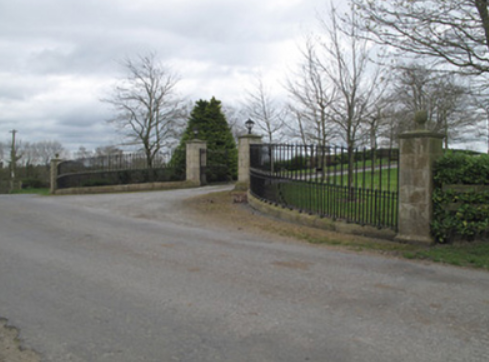
|
| Fort Laurel | Patrick and Hugh Maguire were leasing over 60 acres from the Palmer estate at Ardogelly at the time of Griffith's Valuation. Fort Laurel House was later built at this property. It was renovated in the late twentieth century and is now a family home. |
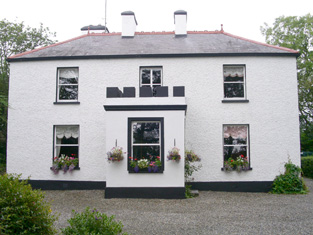
|
| Fort Lodge | John B. Gumbleton was leasing this property to Richard Donovan at the time of Griffith's Valuation, when it was valued at £7. In 1837 Lewis noted it as the seat of R. O'Donovan. It is now in ruins. | |
| Fort Moylan | Home of the Moylan family on the Egmont estate, occupied by Cornelius Moylan at the time of Griffith's Valuation when the buildings were valued at £10. Still extant and occupied |

|
| Fort Nisbitt | Robert Nesbett was resident at Fort Nesbett in 1814. The Ordnance Survey Name Books also mention him in 1839 though they refer to Thomas Towers as the proprietor of the townland. In the early 1850s, Thomas O'Brien was the occupier, holding the property from the Reverend James Nesbitt. The buildings were valued at £12.15 shillings. A building is still located at this site. | |
| Fort Prospect (Clonakilty) | Reverend Benjamin Swete was leasing this property to Richard Wheeler at the time of Griffith's Valuation, when it was valued at £15 15s. In 1837, Lewis notes it as the seat of R. Wheeler. It is still extant. | |
| Fort Richard | John Galway was leasing this house from the Roberts estate at the time of Griffith's Valuation, when it was valued at £16. It is recorded by Lewis as the seat of J. Galway in 1837. A house is still extant at the site. | |
| Fort Robert (Kinneigh) | Described by Lewis in I837 as a "handsome residence" then occupied by Mrs. [O'] Connor. In 1851 it was leased by George Fuller from Mary Longfield [O']Connor and valued at £18. By the mid 1860s it was in the possession of Thomas Kingston Sullivan. The sale rental of 1867 records that Fort Robert had been "allowed to get out of repair, but is beautifully situated". It appears to have become ruinous by 1890s. The Irish Tourist Association Survey of 1944 stated that the ruin was the property of Judge Henry Connor and also that the house had been associated with Art [O']Connor, United Irishman. | |
| Fort Royal | The representatives of Charles Wray were leasing this property from Smith Bryan at the time of Griffiths Valuation in the 1850s when it was valued at £20. This appears to be the property later known as Fort Royal Hotel. It is still extant as a private residence. |
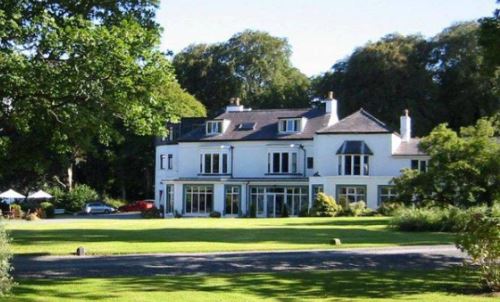
|
| Fort Singleton | The 1st edition 6 inch Ordnance Survey Map (1836) names this house and shows its laid out gardens. The house was the home of the Singleton family, dating from about the mid-18th century. Lewis writes that the home of T. Singleton was ‘situated in a well wooded demesne of 200 acres’ while the Ordnance Survey Field Name Book refers to the ‘neat dwelling house and good office houses’ and that the demesne ‘contains a great deal of fine ash, elm and beech’. The buildings were valued at £60 in Griffith’s Valuation and Whitney Moutray was the occupant, holding from Thomas C. Singleton. Henry Abercrombie, land steward, and his wife were resident in 1901. In more recent times this building has undergone renovation. |
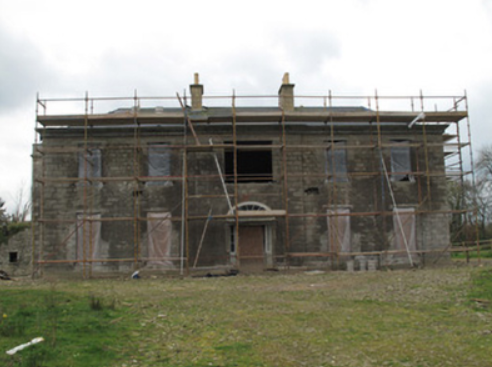
|
| Fort Stewart (KIlmacrenan) | Sir James Stewart was leasing this property from the estate of Thomas Brooke at the time of Griffiths Valuation in the 1850s, when it was valued at £50. In 1837 Lewis also noted it as the seat of Sir J. Stewart. Buildings are still extant at the site. | |
| Fort William | A Parker residence in the early part of the 19th century. In 1841 the Ordnance Survey Name Books referred to it as "a splendid demesne and fine mansion house, the residence of Mr. Parker". By the time of Griffith's Valuation Fort William was occupied by Miss Crawford who held the property from Messrs Egan. The buildings were valued at £18.15 shillings. The Egan sale rental of 1854 gives details of the original lease which was from Charles Egan to John Greene in 1769 for three lives renewable for ever. The last renewal was dated 1803 from John Egan to William Crawford. This house is still in use. |

|
| Fort William | The Ordnance Survey Name Books refer to correspondence with John Cooke in the parish of Glenkeen in 1840. This house was occupied by Mrs Margaret Cooke in the mid 19th century and held from the Earl of Portarlington, valued at £13.10 shillings. John W. Cooke was resident here in the 1870s. Fort William is still extant and occupied. |
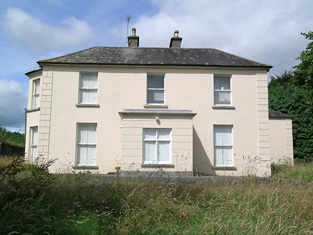
|
| Fort William (Ballyshannon) | William Tredennick was occupying this property at the time of Griffith’s Valuation, when it was valued at £28. The National Inventory of Architectural Heritage suggests it remained in the ownership of the Tredennick family until the 1920s. It is still extant and occupied | |
| Fort William (Cornashesk) | A house and outbuildings are marked on the first edition six inch Ordnance Survey map (publ. 1837). Leet records Charles Kellett as the occupant of Corna-sesk in 1814. The house, which had expanded, is named on the 25 inch map. Fort William was the home of Robert Kellett in the 1850s, held from the Marquess of Headfort and valued at £14. Fortwilliam, Virginia, was the home of Ralph Harman in 1876. It is still extant. | |
| Fort William House | Fort William was the residence of a branch of the Odell family in the 18th century. Occupied by Reverend John Graves in 1814. Mrs Graves had a flour mill here in 1837 but T. O'Dell was living at Fort William. The Ordnance Survey Name Book states that this house was formerly the residence of William Brown of Springmount ''at present occupied by a herdsman''. The residence of Richard D. Power in the mid 19th century who held the property valued at £11 from John B. Graves (in Chancery). The home of Goodricke Thomas Peacocke in the 1880s. This house is still extant and occupied. |

|
| Fort William [Kinalea] | Charles L. Bernard held Fort William in fee at the time of Griffith's Valuation, when it was valued at almost £9. Lewis refers to it as the seat of William Penrose in 1837. Buildings remain at the site. | |
| Fort William/Errigal | Situated on the north side of the Annalee River, Fort William is named on the first edition six inch Ordnance Survey map (publ. 1837). By the time of Griffith’s Valuation it was owned and occupied by Samuel Moorhead. The rateable valuation was £25. The house was extended and renamed ‘Errigle’ as shown on the 25 inch map. In 1906, it had a rateable valuation of £40 and was occupied by Thomas H. Moorhead MD. It now functions as the Errigal Country Hotel. | |
| Fort William/Fort Lyster | A house on the outskirts of the village of Athleague, it was the home of N. J. French in 1837. It was valued at £20 and was occupied by Henry West who held the property from Anne Lyster in the 1850s. The house, marked as Fort William on the first Ordnance Survey map, later became known as Fort Lyster. Still valued at £20 and occupied by the representatives of William Jameson in 1906. It was the home of Aileen Cust the first woman veterinary surgeon in the British Isles in the early 20th century. Modern farm buildings occupy the site but the entrance gates remain. |

|
| Fortfield House | Located close to Lisheen Castle, occupied by H. Lloyd in 1837 and by William Butler at the time of Griffith's Valuation. William Butler was married to Catherine Lloyd and held Fortfield, valued at £19+, from his father in law John Lloyd. Home of the Everard family since the mid 19th century. see http://www.lisheencastle.com/?page_id=2 | |
| Forthill Cottage | Lewis records a Burke family resident at Forthill in the parish of Kilbeacanty in 1837. By the time of Griffith's Valuation the holding was being leased by Michael Diviney from William Gregory. The house was valued at £2 but was vacant at that time. It is no longer extant. | |
| Fortland | The Jacksons held this property from the Pratts of Enniscoe. It was described in the 1830s as a plain house ornamented with a few trees and scrubs. At the time of Griffith's Valuation it was leased by George H. Jackson from Mervyn Pratt when it was valued at £12. It is still extant ad now owned by Billy Cook. |

|
| Fortland | Wilson, writing in 1786 refers to "Fortland, pleasantly situated on the banks of the river Easky" as the seat of Mr. Browne. It later passed to the Jones estate. Both Leet in 1814 and Lewis in 1837 record it as a Jones property. In the mid nineteenth century it was bought by Richard Graves Brinkley who was leasing it to John Wingfield King at the time of Griffith's Valuation when it was valued at £14. It was offered for sale in the Landed Estates Court in 1874 when it was occupied by Mrs. Charlotte Lloyd, presumably a relative of Richard Brinkley's wife, Hester Lloyd. In 1906 it was the property of John L. Brinkley and was valued at £39. McTernan notes that the house was afterwards damaged by fire and partially demolished. Various buildings, including substantial remains of an estate farmyard, survive at this site. |
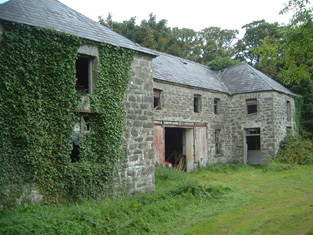
|
| Fortland | Leet records Fort-land, Mount Nugent, as the home of the Reverend H. Maxwell in 1814. Lewis records W. Gosling as the occupant of Fortland in 1837. The first edition Ordnance Survey map (publ. 1837) shows Fortland to have been a substantial property with laid out gardens and plantations and a demesne of over 300 acres. It was the home of the Hon Somerset Maxwell at the time of Griffith’s Valuation. He held the property in fee and the buildings were valued at £27. By 1906 this valuation had increased to £52.10.0. and the house was the home of Mrs Maxwell. The house is demolished and the site now a green field. | |
| Fortland Cottage | Fortland Cottage was built on part of the Cullen estate in the 18th and was the home of Jane Cullen and her husband G. Gledstanes in the mid-nineteenth century. |

|
| Fortland House | John Massy was leasing a building valued at £8 to John Rutherford here in 1856. This is Fortland House which is still extant and occupied. | |
| Fortlands | Fortlands was occupied by members of the Batwell family in the first half of the 19th century. Hajba writes that the Batwells held the property from the Hutchins family. By the mid 19th century Samuel Hutchins was occupying the house, held by him in fee and valued at £31+. The home of the O'Connor family in the 20th century. The original house does not appear to be extant. | |
| Fortlands House (Loughrea) | In 1786 Wilson refers to a charter-school at Loughrea and this premises is labelled on the 1st edition Ordnance Survey map. However, by the time of Griffith's Valuation, it appears to have reverted to use as a house, leased by John Smyth from the Clanricarde estate and valued at £11. The house at this location is labelled Fortlands House on the 25-inch Ordnance survey map of the 1890s. A house is still extant at the site. | |
| Fortlawn Cottage | William Mulrooney held this property in fee at the time of Griffith's Valuation when it was valued at £5. It is labelled as Fortlawn Cottage on both the 1st and 25-inch edition Ordnance Survey maps. A house is still extant at the site. | |
| Fortmoy House Lower | In 1840 the Ordnance Survey Name books refer to "Fordmoy" as "a good dwellinghouse, lately built, the residence of Mr. Prendergast".This house was vacant at the time of Griffith's Valuation. Thomas G. Prendergast was the immediate lessor and the house was valued at £11. Buildings valued at £27.5 shillings were held by the representatives of David Clarke at Fortmoy in 1906. Fortmoy House Lower is still extant. |
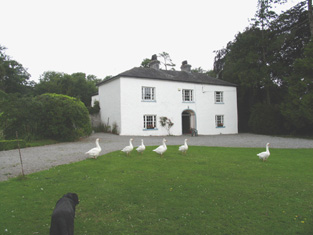
|
| Fortview | At the time of Griffith's Valuation occupied by Erasmus Lloyd who held it from William Lloyd. This house is labelled Fortview on the 25-inch edition map of the 1890s. A house is still extant at the site. | |
| Fortville | Fortville was occupied by Robert Fair in 1814. At the time of Griffith's Valuation it was the residence of Anthony Kyne. Now the home of the Curran Flannery family, the Curran family having lived there since the 1910s. |
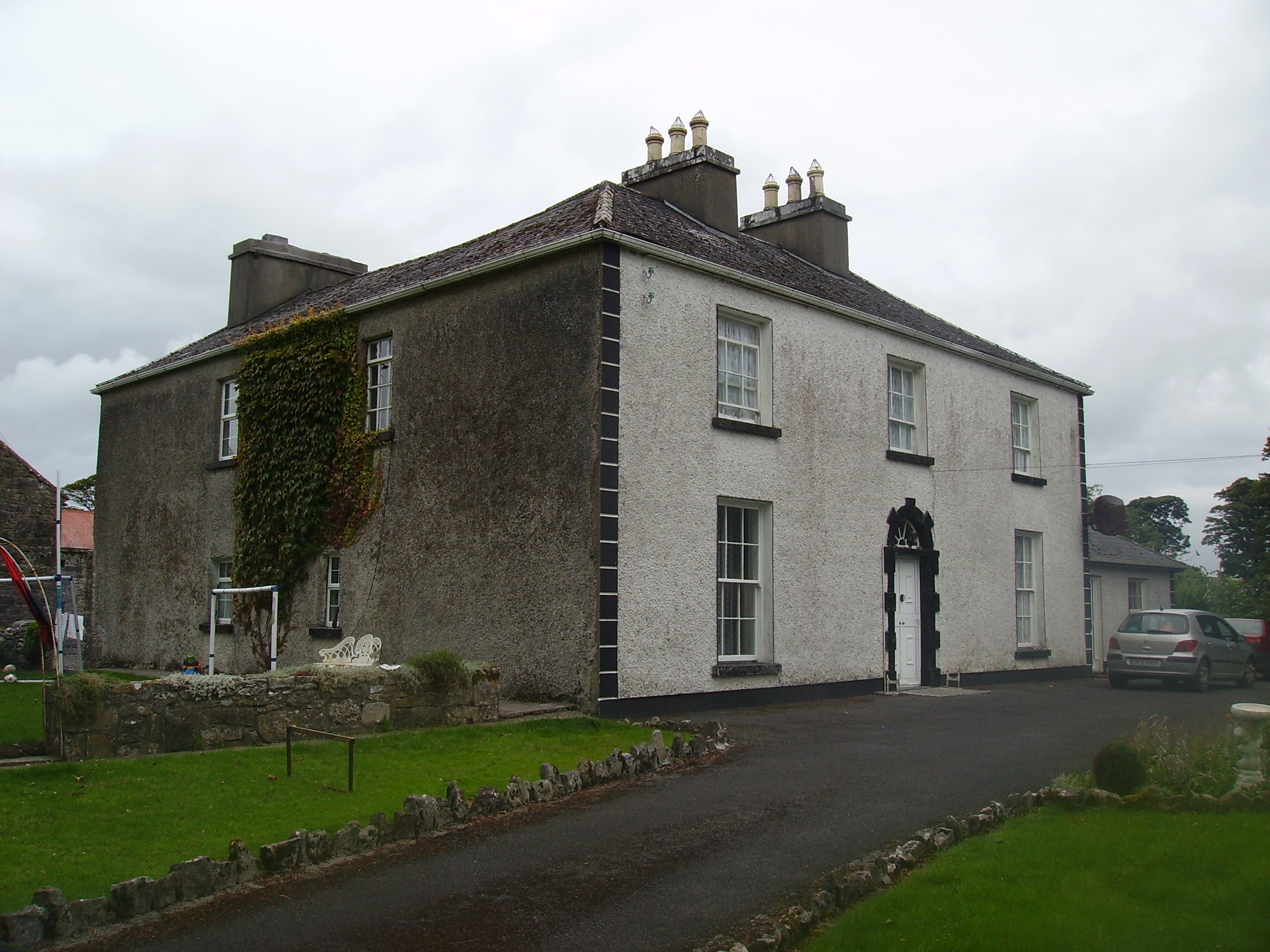
|
| Fortwilliam | At the time of Griffith's Valuation William Lancaster was leasing a property valued at £25 from the Trench estate at Ardcarn, barony of Moycarn. At the same time Thomas Lancaster was leasing a property to Capt. James Bell. In 1786 Wilson refers to Fortwilliam as the seat of Mr. Lancaster. A modern house occupies the site at Fortwilliam but there are remains of yard buildings and a walled garden. |

|
| Fortwilliam | Thomas B. Hurley was leasing this property from the Talbot-Crosbie estate at the time of Griffith's Valuation, when it was valued at £18 10s Lewis records the house in Killahan parish when he notes that it as belonging to the representatives of the late W. Collis in 1837. Leet states that William Fitzgerald was resident at Fortwilliam in 1814. . Bary writes that, according to O'Donovan, this house was built by William Collis in 1798. It is no longer extant. | |
| Fortwilliam | A house on the Evans estate occupied by William Barry at the time of Griffith's Valuation when it was valued at £23, later a Sheehy residence. The Sheehy sale rental of 1875 records the house containing 3 reception rooms and 5 bedrooms. It was conveyed to Robert K. Sheehy by Edward R. C. Barry on 7 January 1874 and advertised for sale in June 1875. The National Inventory of Architectural Heritage dates this Tudor Revival house from circa 1880 to the design of Sir John Jackson (1851-1919), so the present house may incorporate the earlier one which is marked on the first Ordnance Survey map. In 2006 this house was no longer occupied. |
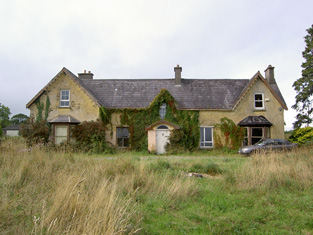
|
| Fortwilliam (Castlereagh) | The estate of William W.R. Sandford was leasing the house at Ballyfinegan, barony of Castlereagh, to Patrick Tighe at the time of Griffith's Valuation when it was valued at £11. Lewis records a house called Fortwilliam in the parish of Ballintober as the seat of P. Teighe in 1837. The Census of Elphin recorded William Compton as resident at Ballyfinegan in 1749. There is still an extant house at the site. | |
| Fortwilliam House | Named as Lissyviggeen on the 1st edition OS map but as Fort William House on the map of 1896. At the time of Griffith’s Valuation, John Dumas was leasing this property from the Kenmare estate, when it was valued at £11. Bary states that the O’Keeffe family purchased the property in the 1880s. It was still extant and occupied in 1994. | |
| Fortwilliam House (Waterford) | In 1851 J.B. Gumbleton held this property in fee when it was valued at £47 10s. Lewis also refers to it as his seat in 1837 when he describes it as " a handsome demesne with a new house being erected". The ITA survey noted it as the residence of Mr. P. Dunne in 1942. Fortwilliam is still extant and occupied. In 2024 it was offered for sale. |
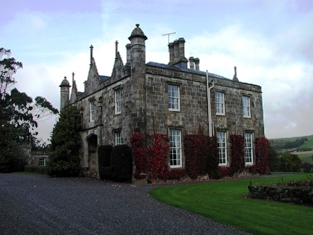
|
| Fota House | Originally built as a hunting lodge for the Smith Barrys in the 18th century and enlarged in the 1820s to the design of Sir Richard Morrison with further 19th century additions. Valued at £89 and held by James H.S. Barry in fee at the time of Griffith's Valuation. Occupied by Lord Barrymore in 1906 and valued at £160. Inherited by Major and the Honourable Mrs Bell. The Irish Tourist Association survey provides details of some of the paintings in the house and exotic plants in the gardens. Bence Jones writes that Fota was sold to University College, Cork in 1975 following the death of Mrs Bell. It is now in the care of the Irish Heritage Trust and after restoration was reopened to the public in 2009. http://www.fotahouse.com/display.php |

|
| Fountainhill | The home of a branch of the Jennings family for over a hundred years, now a ruin. The house was held in fee by Patrick Blake at the time of Griffith's Valuation, when it was valued at £10. |

|
| Fountainstown | Francis Hodder was leasing this property to George Hodder at the time of Griffith's Valuation, when it was valued at £24. In 1837 Lewis referred to Fountainstown as the seat of G. Hodder. Local sources indicate that this house originally belonged to the Roche family whose lands the Hodders were granted and that the oldest part of Fountainstown House was the original Roche property. In the 1940s the Irish Tourist Association Survey noted that it was listed in the Association's directory of hotels. Fountainstown is still extant and occupied. |

|
| Four Mile Water Court or Durrus Court | Rev. Alleyn Evanson was leasing this property from the Earl of Bandon's estate at the time of Griffith's Valuation, when it was valued at £15. It is labelled Four Mile Water Court on the 1st edition Ordnance Map and Durrus Court on the later 25-inch edition. In 1837, Lewis recorded it as Four Mile Water Court, the seat of A. Evanson. It is still extant. | |
| Foxborough | In 1786 Wilson refers to Foxborough as the seat of Arthur French. Occupied by Patrick Taaffe at the time of Griffith's Valuation, who was leasing from Christopher French. The house was then valued at £20. It is now a ruin though the stable yard survives. | |
| Foxfield House | In 1814, Andrew Bell was resident at Foxfield (N435 888). In the 1850s John George Parr lived at Foxfield House, a residence on the other side of the road from the original Foxfield, which he held in fee. It was valued at £8 for rates. This house continues to be occupied. | |
| Foxhall | In 1786 Wilson refers to Foxhall as the seat of Mr. Anderson. It was the home of a branch of the Rose family in the 19th century following the marriage of Mary Anderson and Richard Rose. Richard A. Rose was resident in 1814 and J. O'Brien in 1837. In 1840 the Orddnance Survey Name Books refer to it as the residence of Dr. Ryordan, " a commodious dwelling house". At the time of Griffith's Valuation W.A. Rose occupied the house valued at £27+ and held in fee. This house is now demolished. |

